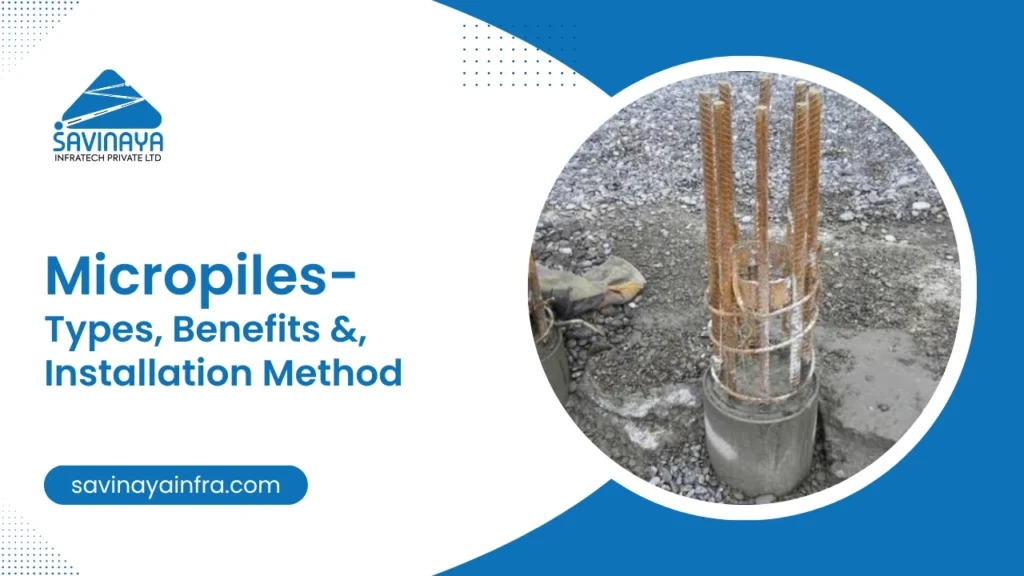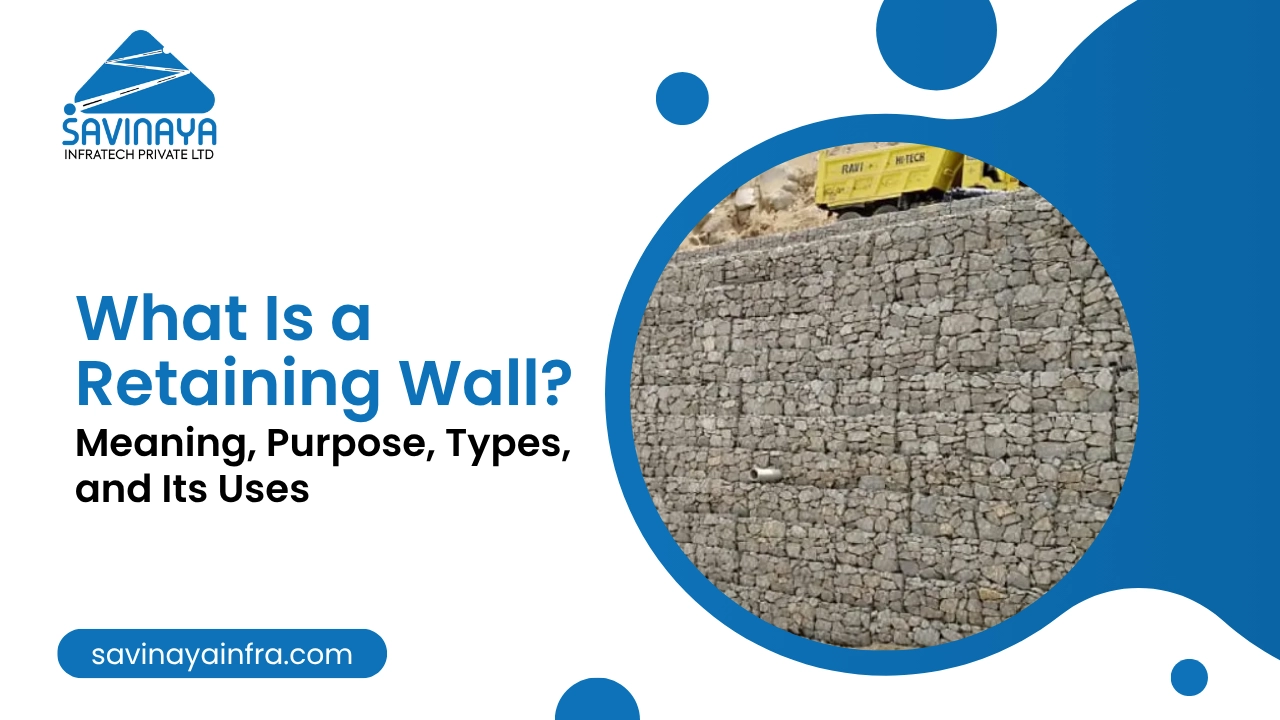When dealing with complex soil conditions, restricted access sites, or existing structures that need foundation strengthening, one modern solution stands out—micropiles. Also known as mini piles, these high-capacity, small-diameter drilled piles have become an integral part of today’s foundation and geotechnical engineering.
Their adaptability, ease of installation, and ability to carry significant loads make micropiles an ideal choice across a wide range of infrastructure projects, especially where traditional piling methods fall short.
Table of Contents
What is a Micropile?
A micropile is a small-diameter (usually less than 300 mm) deep foundation element constructed using high-strength steel reinforcement and cement grout. It is drilled and grouted into place, allowing it to transfer loads to competent strata or rock.
Used widely in new construction and structural retrofitting, micropile foundations are especially valuable in areas with low headroom, limited access, or unstable ground conditions. Their strength comes from a combination of the micropile grouting method and the steel bar or casing used as reinforcement.
Types of Micropiles
There are different types of micropiles, such as;
1. Type A – Grouted Gravity-Fed Micropiles
Grout is introduced into the hole without pressure. It relies mainly on frictional resistance along the length of the pile.
2. Type B – Pressure Grouted Micropiles
Grout is injected under moderate pressure to improve bond with the surrounding soil. This is a widely used micropiling method in both urban and remote environments.
3. Type C – Post-Grouted Micropiles
These involve additional high-pressure grout injection after the initial installation. This technique significantly improves capacity and is ideal for high-load applications.
4. Type D – Drilled and Grouted with Casing
A steel casing is left in the ground along with grout and central reinforcement. This micro piling technique is used in unstable soils or areas prone to collapse during drilling.
Choosing among these types of micropiles depends on load requirements, soil conditions, and construction access.
Interesting Reads: What Is Micropiling? A Guide to This Powerful Foundation Technique
What are the Methods of Installation of Micropiles?
The micropile installation procedure involves several key steps:
- Drilling the Borehole
The borehole is drilled using rotary, rotary-percussive, or auger methods depending on ground conditions. - Placing Reinforcement
A steel bar or casing is inserted into the hole. The choice of reinforcement is determined by the specific structural requirements of the project. - Grouting
High-strength cement grout is pumped into the borehole. Depending on the micropiling method, grout may be gravity-fed or pressure-injected to bond with the surrounding soil or rock. - Curing
The micropile is left to cure for a specific period before load testing or structural connection.
In difficult terrains or sensitive environments, the micro piling procedure is often faster and less disruptive than conventional piling.
Advantages of Micropiles
Micropiles offer a number of practical and engineering benefits:
- Minimal equipment footprint, ideal for confined or urban spaces.
- High load-bearing capacity in both tension and compression.
- Applicable in all soil types, including cobbles, gravel, or soft clay.
- Quick installation, even in adverse weather or soil conditions.
- Ideal for underpinning and retrofitting existing structures.
- Low vibration and noise, making them suitable for sensitive areas.
Thanks to their flexibility and adaptability, micropiling has become a go-to solution for many builders & engineers.
Interesting Reads: ODEX Micropiling: Meaning, Uses, and Advantages in Overburden Conditions
What are Micropiles Used for?
Micropiles serve multiple roles in construction and ground stabilisation, such as:
- Supporting new buildings in poor soil conditions
- Use to Strengthening the foundations of bridges, towers, and industrial structures
- Underpinning heritage or historic structures
- Stabilising slopes and embankments
- Use a Tunnelling and shaft construction support
- Earthquake-resistant foundation retrofitting
The small diameter and strength of micropile foundations make them perfect for projects requiring precision and reliability.
Applications of Micropiles
Here are some common real-world applications where micropiles prove their value:
- Urban construction: Ideal for sites with restricted access or limited vertical clearance
- Infrastructure upgrades: Strengthening aging bridges and highways
- Slope stabilisation: Slope stabilisation solutions hold back landslides in hilly or mountainous terrain
- Tunnel reinforcement: Used in portal zones or near excavation walls
- Seismic upgrades: A dependable option for retrofitting foundations in earthquake-prone zones
Their adaptability across these situations has made micropiling a preferred method in modern geotechnical engineering.
Why Micropiles Are Preferred Over Conventional Piles?
Traditional piles often require large rigs, heavy equipment, and significant clearance—luxuries not always available. Here’s why micropiles are a better fit in many projects:
- Can be installed in tight or low-clearance spaces
- Less ground disturbance and fewer environmental impacts
- Ideal for difficult soil conditions
- Compatible with sensitive structures or utilities
- Cost-effective when considering time and flexibility
When conditions are challenging and precision is key, micropile installation procedures outperform conventional piling both in speed and efficiency.
Interesting Reads: Soil Nailing and Geotechnical Design: Insights for Stability Solutions
Conclusion
As construction becomes more complex and space more limited, micropiles are proving to be a game-changing solution for deep foundation systems. Their ability to deliver strength, flexibility, and stability in tough conditions makes them a smart choice for engineers and developers alike.
As a professional micro piling contractor, we specialize in advanced micropiling techniques, customized for your project’s soil profile, load requirements, and site constraints. Let our expertise help you build stronger, smarter, and safer foundations. Contact us to discuss your business needs.
Frequently Asked Questions (FAQs)
-
Where are Micropiles used?
Micropiles are used in a wide range of projects where traditional deep foundations are not practical. They are ideal for urban construction, sites with restricted access, areas with poor soil conditions, seismic retrofitting, and slope stabilization. Additionally, micropiles are frequently used to strengthen existing foundations and support new structures where minimal vibration is required.
-
What are the applications of Micropiles?
Micropiles underpin existing buildings, support bridges and towers, stabilize slopes, prevent landslides, reinforce tunnels, and strengthen foundations in seismic zones. Their versatility makes them ideal for both new construction and retrofitting projects across various industries.
-
What is the main function of micropile?
The primary function of a micropile is to transfer structural loads from the surface to deeper, more stable soil or rock layers. They help provide foundation stability in challenging ground conditions, prevent settlement, and increase load-bearing capacity. Micropile foundations are also effective in retrofitting and strengthening aging or damaged structures.
-
What is the process of micropile?
The micropile installation procedure involves drilling a small-diameter borehole to the required depth, inserting a steel reinforcement bar or casing, and pumping high-strength grout to bond the pile with the surrounding soil or rock. Once the grout cures, the micropile forms a solid load-bearing element. This micro piling procedure is well-suited for efficient installation in confined or sensitive environments.


